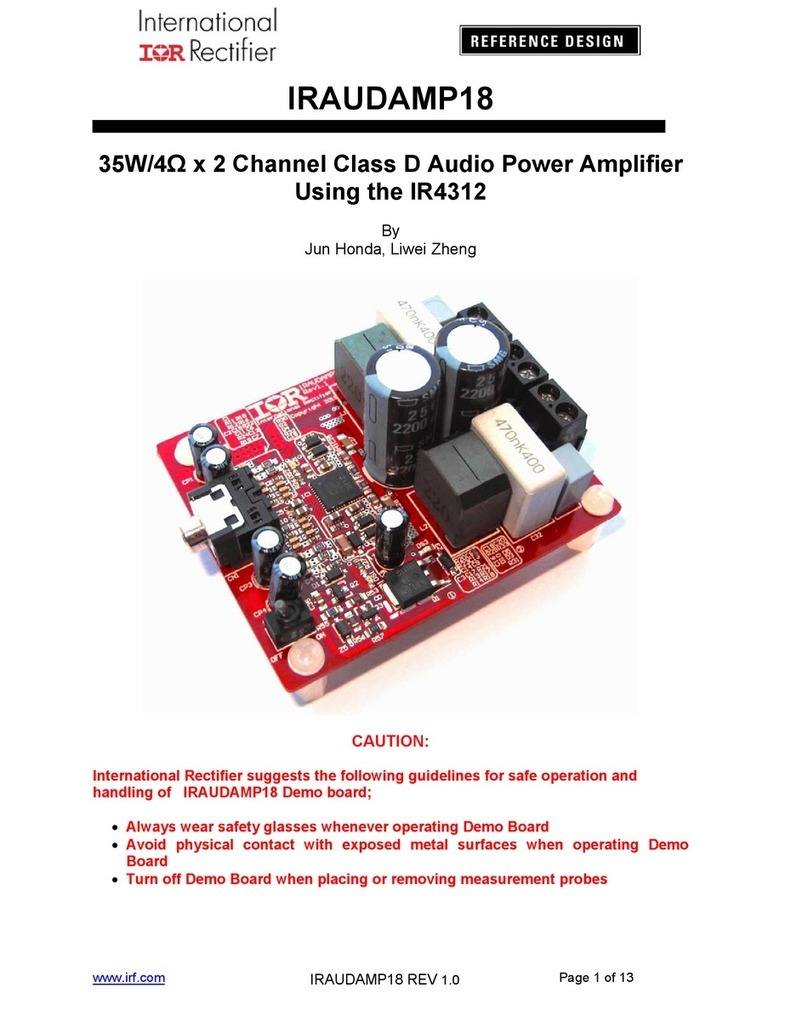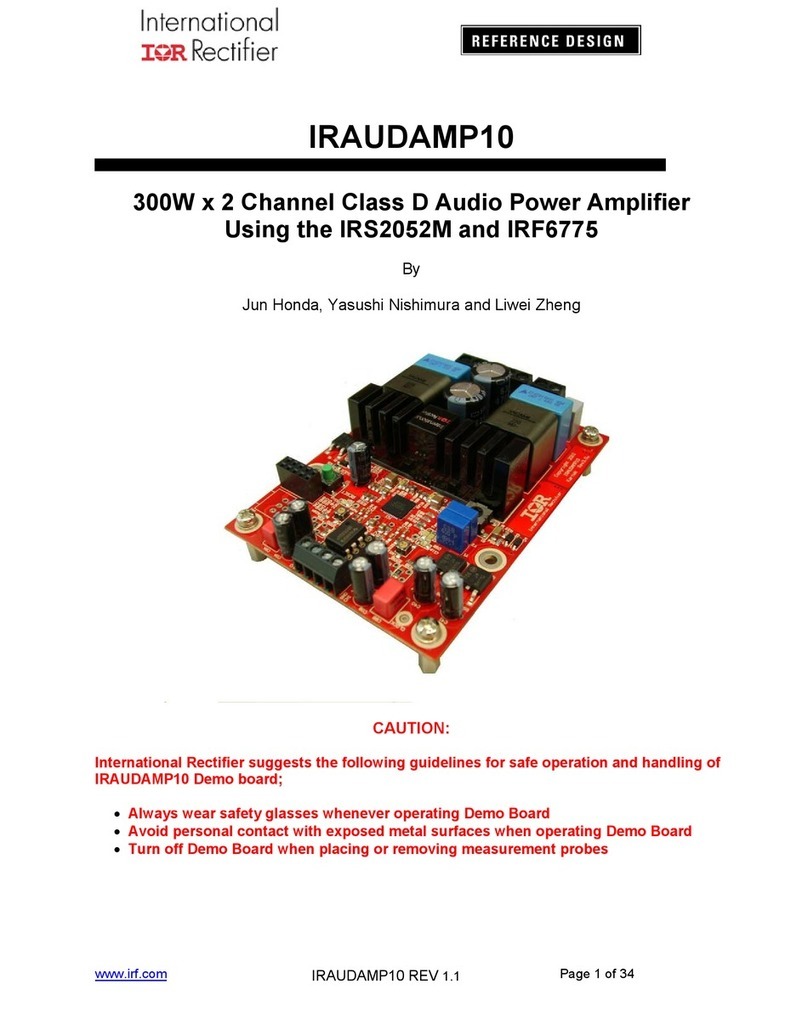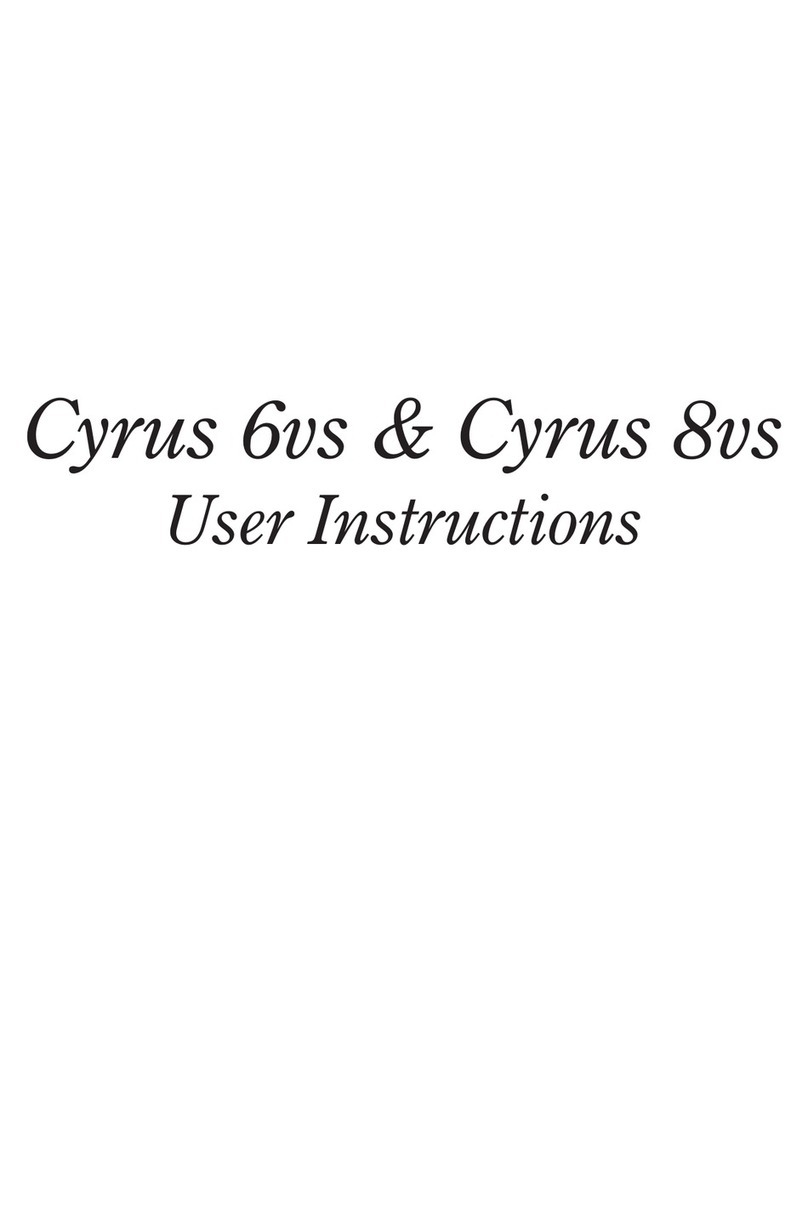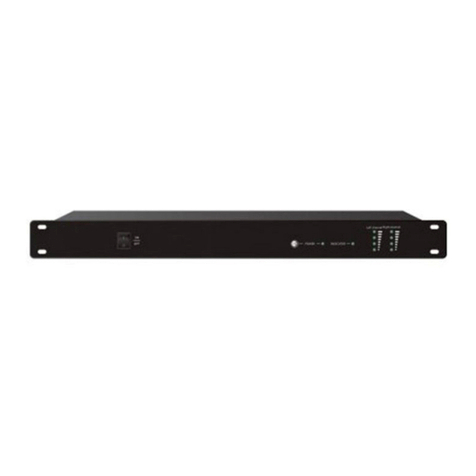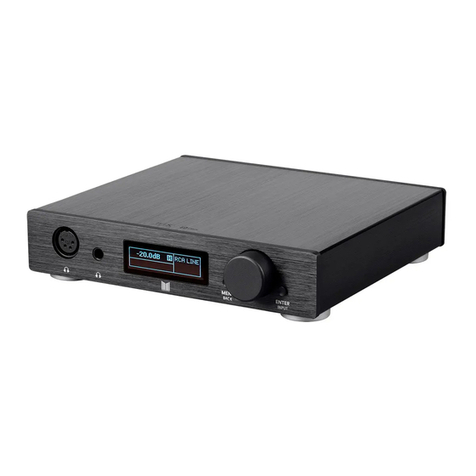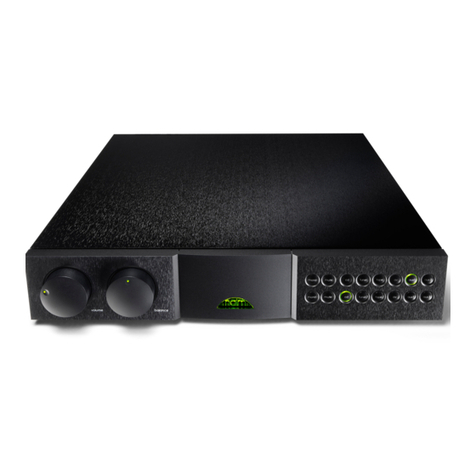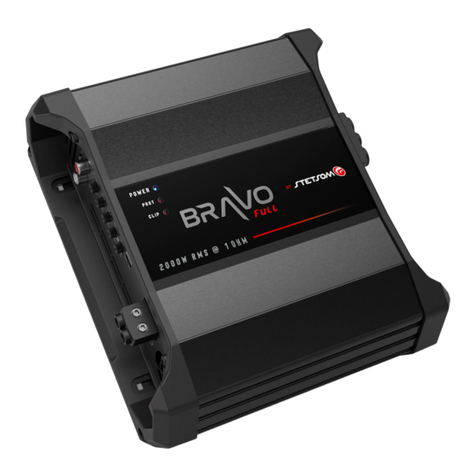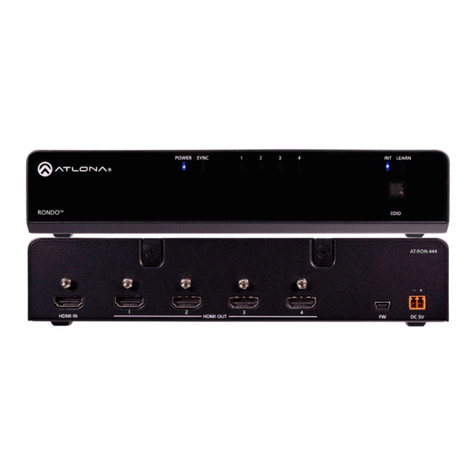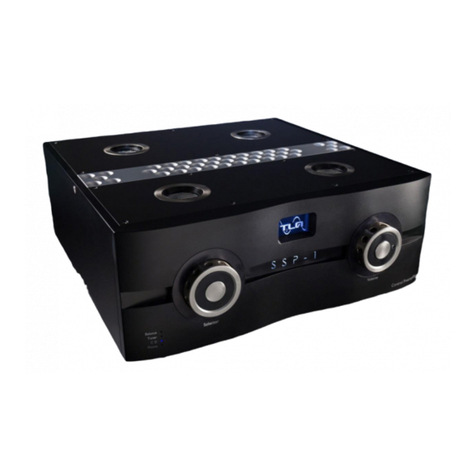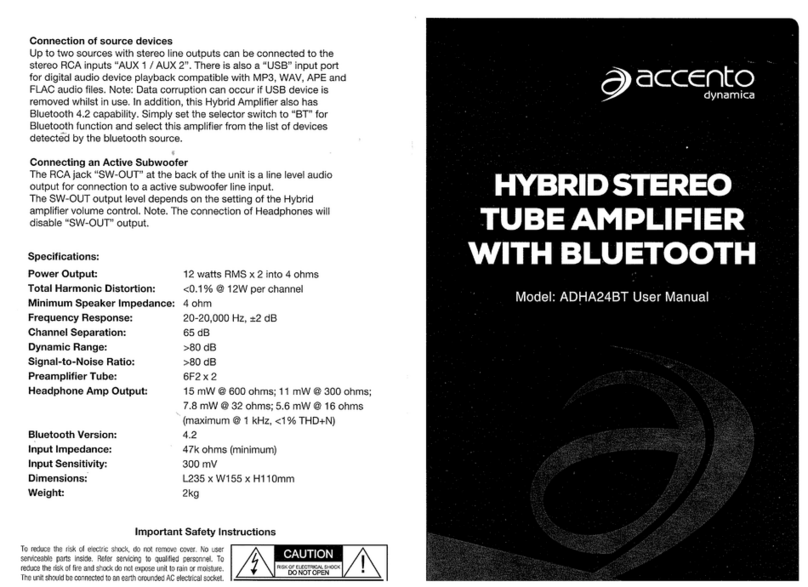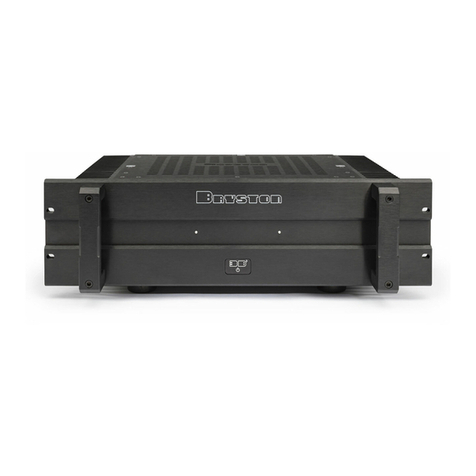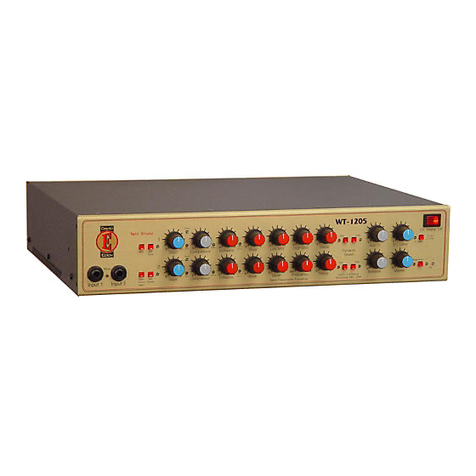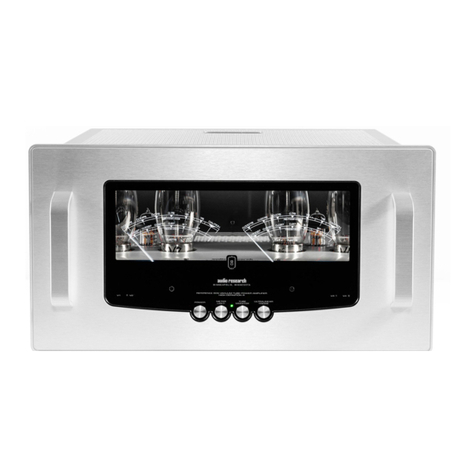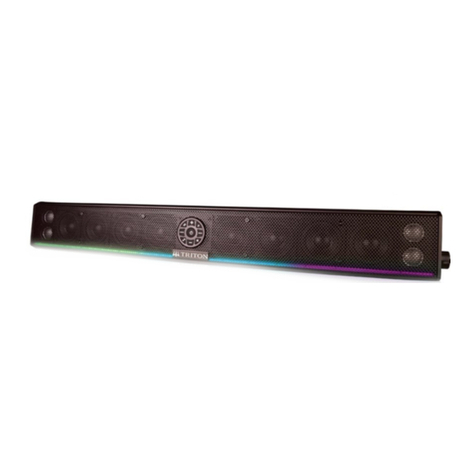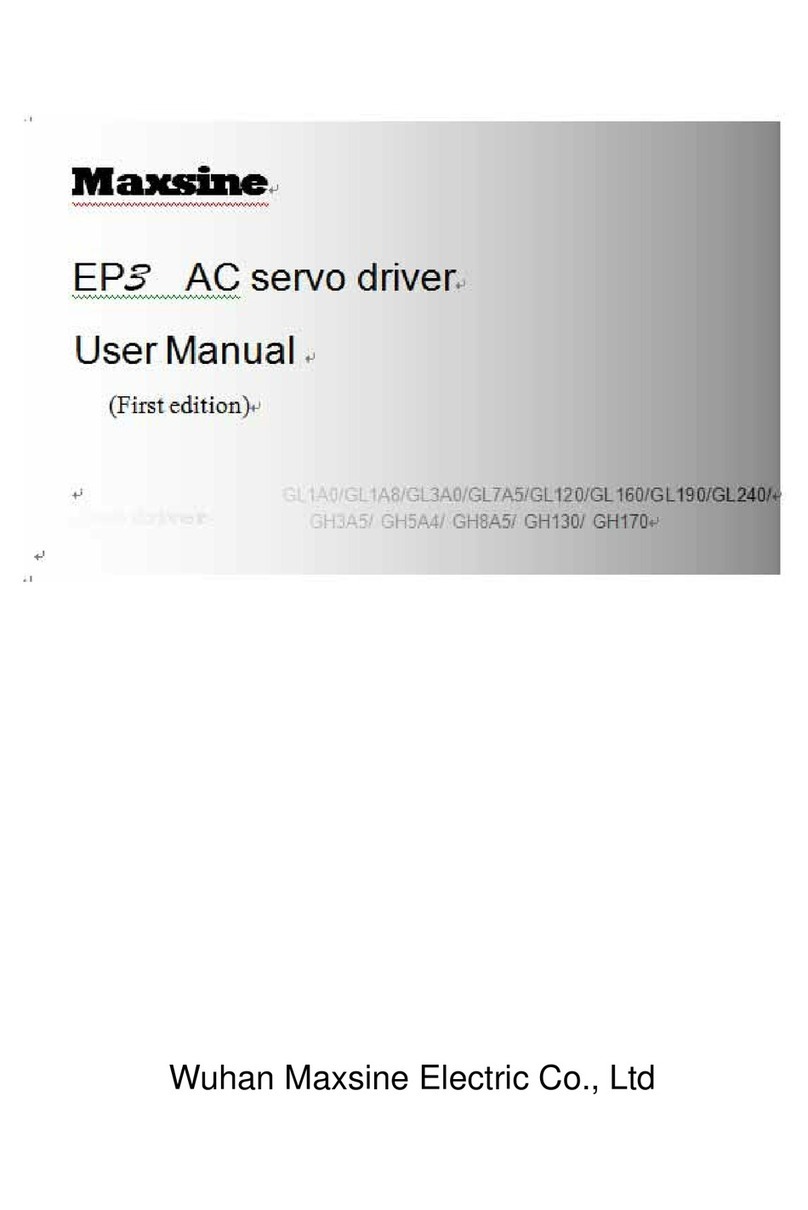International Rectifier IRAUDAMP4 User manual

www.irf.com
RD-0617
IRAUDAMP4
120 W x 2 Channel Class D Audio Power Amplifier
Using IRS20955 and IRF6645
By
Johan Strydom, Jun Honda, and Jorge Cerezo
Table of Contents
Page
Introduction .......................................................................................... 1
Specifications ....................................................................................... 2
Functional Description.......................................................................... 4
Startup and Shutdown..........................................................................12
Protection.............................................................................................16
Typical Performance ............................................................................21
Design Documents ..............................................................................27
CAUTION: International Rectifier suggests the following guidelines for
safe operation and handling of IRAUDAMP4 Demo Board;
•Always wear safety glasses whenever operating Demo Board
•Avoid personal contact with exposed metal surfaces when operating
Demo Board
•Turn off Demo Board when placing or removing measurement probes

www.irf.com 1
RD-0617
Introduction
The IRAUDAMP4 reference design is an example of a two-channel 120 W half-bridge
Class D audio power amplifier. The reference design will demonstrate how to use the
IRS20955, implement protection circuits, and design an optimum PCB layout using the
IRF6645 DirectFET MOSFETs. The resulting design requires no heatsink for normal
operation (one-eighth of continuous rated power). The reference design contains all the
required housekeeping power supplies for ease of use. The two-channel design is
scalable, for power and the number of channels.
Applications
AV receivers
Home theater systems
Mini component stereos
Sub-woofers
Features
Output Power: 120 W x two channels,
Total Harmonic Distortion (THD) = 1%, 1 kHz
Residual Noise: 52 µV, IHF-A weighted, AES-17 filter
Distortion: 0.004% THD+N @ 60 W, 4 Ω
Efficiency: 96% @ 120 W, 4 Ω, single-channel driven, Class D stage
Multiple Protection Features: Over-current protection (OCP),
Over-voltage protection (OVP),
Under-voltage protection (UVP),
DC-protection (DCP),
Over-temperature protection (OTP)
PWM Modulator: Self-oscillating half-bridge topology with optional clock
synchronization

www.irf.com 2
RD-0617
Specifications
General Test Conditions (unless otherwise noted) Notes / Conditions
Supply Voltage ±35 V
Load Impedance 4 Ω
Self-Oscillating Frequency 400 kHz No input signal
Gain Setting 26.8 dB 1 Vrms input yields rated power
Electrical Data Typical Notes / Conditions
IR Devices Used IRS20955 gate driver,
IRF6645 DirectFET MOSFET
Modulator Self-oscillating, second order sigma-delta modulation, analog input
Power Supply Range ± 25 - 35 V
Output Power CH1-2: (1% THD+N) 120 W 1 kHz
Output Power CH1-2: (10% THD+N) 170 W 1 kHz
Rated Load Impedance 4 Ω
Supply Current 100 mA No input signal
Total Idle Power Consumption 7 W No input signal
Channel Efficiency 96% Single-channel driven,
120 W, Class D stage
Audio Performance Typical / Class D* Notes / Conditions
THD+N, 1 W
THD+N, 10 W
THD+N, 60 W
0.005%
0.002%
0.004%
0.002%
0.001%
0.003%
1 kHz, Single-channel driven
Dynamic Range 113 dB 120 dB A-weighted, AES-17 filter,
Single-channel operation
Residual Noise, 20Hz - 20 kHz BW,
A-Weighted
70 µV
50 µV
40 µV
20 µV
Self-oscillating – 400 kHz
Internal clock – 300 kHz
Damping Factor 170 2000 1 kHz, relative to 4 Ωload
Channel Separation 95 dB
80 dB
100 dB
85 dB
100 Hz
10 kHz
Frequency Response : 20Hz-20 kHz
: 20Hz-40 kHz
±1 dB
±3 dB
1W, 4 Ω- 8 ΩLoad
Thermal Performance Typical Notes / Conditions
Idling TC =30 °C
TPCB=37 °C No signal input, TA=25 °C
2ch x 15 W (1/8 rated power) TC =54 °C
TPCB=67 °C Continuous, TA=25 °C
2ch x 120 W (rated power) TC =80 °C
TPCB=106 °C
At OTP shutdown @ 150 s,
TA=25 °C
Physical Specifications
Dimensions 5.8 in (L) x 5.2 in (W)
Note: Specifications are typical and not guaranteed
*Class D refers to audio performance measurements of the Class D output power stage
only, with preamp and output filter bypassed.

www.irf.com 3
RD-0617
Connection Diagram
Figure 1. Typical Test Setup
Pin Description
CH1 IN J6 Analog input for CH1
CH2 IN J5 Analog input for CH2
POWER J7 Positive and negative supply (+B / -B)
CH1 OUT J3 Output for CH1
CH2 OUT J4 Output for CH2
EXT CLK J8 External clock sync
DCP OUT J9 DC protection relay output
Power-on and Power-off Procedure
Always apply or remove ±35 V bus supplies at the same time.
Volume
J6 J5
J3 J4
J7
R113
S3 S2
TP1 TP2
CH1
Output CH2
Output
CH1
Input CH2
Input
G
Protection
Normal
S1
LED
35 V, 5 A DC supply
4 Ω4 Ω
35 V, 5 A DC supply
250 W, Non-inductive Resistors
J8
J9
Audio Signal Generator

www.irf.com 4
RD-0617
Functional Description
Class D Operation
Referring to CH1 as an example, the op-amp U1 forms a front-end second-order
integrator with C11, C13 & R25 + R29P. This integrator receives a rectangular feedback
waveform from the Class D switching stage and outputs a quadratic oscillatory waveform
as a carrier signal. To create the modulated PWM signal, the input signal shifts the
average value of this quadratic waveform (through gain relationship between R13 and
R31 + R33) so that the duty varies according to the instantaneous value of the analog
input signal. The IRS20955 input comparator processes the signal to create the required
PWM signal. This PWM signal is internally level-shifted down to the negative supply rail
where this signal is split into two signals, with opposite polarity and added deadtime, for
high-side and low-side MOSFET gate signals, respectively. The IRS20955 drives two
IRF6645 DirectFET MOSFETs in the power stage to provide the amplified PWM
waveform. The amplified analog output is re-created by demodulating the amplified
PWM. This is done by means of the LC low-pass filter (LPF) formed by L1 and C23,
which filters out the Class D switching carrier signal.
Figure 2. Simplified Block Diagram of Class D Amplifier
Power Supplies
The IRAUDAMP4 has all the necessary housekeeping power supplies onboard and only
requires a pair of symmetric power supplies ranging from ±25 V to ±35 V (+B, GND, -B)
for operation. The internally-generated housekeeping power supplies include a ±5 V
supply for analog signal processing (preamp, etc.), while a +12 V supply (VCC),
referenced to –B, is included to supply the Class D gate-driver stage.
For the externally-applied power, a regulated power supply is preferable for performance
measurements, but not always necessary. The bus capacitors, C31 and C32 on the
motherboard, along with high-frequency bypass-caps C15-C18 on daughter board,
address the high-frequency ripple current that result from switching action. In designs
involving unregulated power supplies, the designer should place a set of bus capacitors,
having enough capacitance to handle the audio-ripple current, externally. Overall
regulation and output voltage ripple for the power supply design are not critical when
using the IRAUDAMP4 Class D amplifier as the power supply rejection ratio (PSRR) of
the IRAUDAMP4 is excellent (Figure 3).
IRF6645
Direct-FET
Feedback
GND
LPF
+B
-B
Σ
IRS20955S
Gate Driver
U1 U1
Daughter-board
Integrator
PWM
Modulator
and Level
Shifter

www.irf.com 5
RD-0617
Figure 3. Power Supply Rejection Ratio (PSRR) for Negative (-B) and Positive (+B) Supplies
Bus Pumping
Since the IRAUDAMP4 is a half-bridge configuration, bus pumping does occur. Under
normal operation during the first half of the cycle, energy flows from one supply through
the load and into the other supply, thus causing a voltage imbalance by pumping up the
bus voltage of the receiving power supply. In the second half of the cycle, this condition
is reversed, resulting in bus pumping of the other supply.
These conditions worsen bus pumping:
– Lower frequencies (bus-pumping duration is longer per half cycle)
– Higher power output voltage and/or lower load impedance (more energy
transfers between supplies)
– Smaller bus capacitors (the same energy will cause a larger voltage increase)
The IRAUDAMP4 has protection features that will shutdown the switching operation if
the bus voltage becomes too high (>40 V) or too low (<20 V). One of the easiest
countermeasures is to drive both of the channels out of phase so that one channel
consumes the energy flow from the other and does not return it to the power supply. Bus
voltage detection is only done on the –B supply as the effect of the bus pumping on the
supplies is assumed to be symmetrical in amplitude (although opposite in phase).
Input
A proper input signal is an analog signal below 20 kHz, up to ±3.5 V peak, having a
source impedance of less than 600 Ω. A 30 kHz to 60 kHz input signal can cause LC
resonance in the output LPF, resulting in an abnormally large amount of reactive current
flowing through the switching stage (especially at 8 Ωor higher impedance towards open
load), causing OCP activation. The IRAUDAMP4 has an RC network, or Zobel network,
to damp the resonance and protect the board in such event, but is not thermally rated to
handle continuous supersonic frequencies. These supersonic input frequencies
therefore should be avoided. Separate mono RCA connectors provide input to each of
the two channels. Although both channels share a common ground, it is necessary to
connect each channel separately to limit noise and crosstalk between channels.
-90
+0
-80
-70
-60
-50
-40
-30
-20
-10
d
B
20 40k50 100 200 500 1k 2k 5k 10k 20k
Hz
+B
-B

www.irf.com 6
RD-0617
Output
Both outputs for the IRAUDAMP4 are single-ended and therefore have terminals labeled
(+) and (-) with the (-) terminal connected to power ground. Each channel is optimized
for a 4 Ωspeaker load for a maximum output power of 120 W, but is capable of
operating with higher load impedances (at reduced power), at which point the frequency
response will have a small peak at the corner frequency of the output LC low pass filter.
The IRAUDAMP4 is stable with capacitive-loading; however, it should be realized that
the frequency response degrades with heavy capacitive loading of more than 0.1 μF.
Gain Setting / Volume Control
The IRAUDAMP4 has an internal volume control (potentiometer R108 labeled,
“VOLUME”) for gain adjustment. Gain settings for both channels are tracked and
controlled by the volume control IC (U_2) setting the gain from the microcontroller IC
(U_1). The maximum volume setting (clockwise rotation) corresponds to a total gain of
+37.9 dB (78.8 V/V). The total gain is a product of the power-stage gain, which is
constant (+23.2 dB), and the input-stage gain that is directly-controlled by the volume
adjustment. The volume range is about 100 dB with minimum volume setting to mute the
system with an overall gain of less than -60 dB. For best performance in testing, the
internal volume control should be set to a gain of 21.9 V/V, or 1 Vrms input will result in
rated output power (120 W into 4 Ω), allowing for a >11 dB overdrive.
Output Filter Design, Preamplifier and Performance
The audio performance of the IRAUDAMP4 depends on a number of different factors.
The section entitled, “Typical Performance” presents performance measurements based
on the overall system, including the preamp and output filter. While the preamp and
output filter are not part of the Class D power stage, they have a significant effect on the
overall performance.
Output filter
Since the output filter is not included in the control loop of the IRAUDAMP4, the
reference design cannot compensate for performance deterioration due to the output
filter. Therefore, it is there important to understand what characteristics are preferable
when designing the output filter:
1) The DC resistance of the inductor should me minimized to 20 mΩor less.
2) The linearity of the output inductor and capacitor should be high with respect to
load current and voltage.
Preamplifier
The preamp allows partial gain of the input signal, and in the IRAUDAMP4, controls the
volume. The preamp itself will add distortion and noise to the input signal, resulting in a
gain through the Class D output stage and appearing at the output. Even a few micro-
volts of noise can add significantly to the output noise of the overall amplifier. In fact, the
output noise from the preamp contributes more than half of the overall noise to the
system.
It is possible to evaluate the performance without the preamp and volume control, by
moving resistors R13 and R14 to R71 and R72, respectively. This effectively bypasses
the preamp and connects the RCA inputs directly to the Class D power stage input.
Improving the selection of preamp and/or output filter, will improve the overall system
performance to approach that of the stand-alone Class D power stage. In the “Typical

www.irf.com 7
RD-0617
Performance” section, only limited data for the stand-alone Class D power stage is
given. For example, results for THD+N vs. Output Power are provided, utilizing a range
of different inductors. By changing the inductor and repeating this test, a designer can
quickly evaluate a particular inductor.
Figure 4. Results of THD+N vs. Output Power with Different Output Inductors
Self-Oscillating PWM Modulator
The IRAUDAMP4 Class D audio power amplifier features a self-oscillating type PWM
modulator for the lowest component count and robust design. This topology represents
an analog version of a second-order sigma-delta modulation having a Class D switching
stage inside the loop. The benefit of the sigma-delta modulation, in comparison to the
carrier-signal based modulation, is that all the error in the audible frequency range is
shifted to the inaudible upper-frequency range by nature of its operation. Also, sigma-
delta modulation allows a designer to apply a sufficient amount of correction.
The self-oscillating frequency is determined by the total delay time inside the control loop
of the system. The delay of the logic circuits, the IRS20955 gate-driver propagation
delay, the IRF6645 switching speed, the time-constant of front-end integrator (e.g. R25 +
R29P, C11 and C13 for CH1) and variations in the supply voltages are critical factors of
the self-oscillating frequency. Under nominal conditions, the switching-frequency is
around 400 kHz with no audio input signal and a +/-35 V supply.
Adjustments of Self-Oscillating Frequency
The PWM switching frequency in this type of self-oscillating switching scheme greatly
impacts the audio performance, both in absolute frequency and frequency relative to the
other channels. In absolute terms, at higher frequencies, distortion due to switching-time
becomes significant, while at lower frequencies, the bandwidth of the amplifier suffers. In
relative terms, interference between channels is most significant if the relative frequency
difference is within the audible range. Normally when adjusting the self-oscillating
frequency of the different channels, it is best to either match the frequencies accurately,
0.0001
100
0.001
0.01
0.1
1
10
%
100m 200m 500m 1 2 5 10 20 50 100 200
W
TTTTTTTTT

www.irf.com 8
RD-0617
or have them separated by at least 25 kHz. With the installed components, it is possible
to change the self-oscillating frequency from about 160 kHz up to 600 kHz.
Potentiometers for adjusting self-oscillating frequency
R29P Switching frequency for CH1*
R30P Switching frequency for CH2*
*Adjustments have to be done at an idling condition with no signal input.
Switches and Indicators
There are three different indicators on the reference design:
– An orange LED, signifying a fault / shutdown condition when lit.
– A green LED on the motherboard, signifying conditions are normal and no fault
condition is present.
– A green LED on the daughter board, signifying there is power.
There are three switches on the reference design:
– Switch S1 is a trip and reset push-button. Pushing this button has the same effect of
a fault condition. The circuit will restart about three seconds after the shutdown
button is released.
– Switch S2 is an internal clock-sync frequency selector. This feature allows the
designer to modify the switching frequency in order to avoid AM radio interference.
With S3 is set to INT, the two settings “H” and “L” will modify the internal clock
frequency by about 20 kHz to 40 kHz, either higher “H” or lower “L.” The actual
internal frequency is set by potentiometer R113 - “INT FREQ.”
– Switch S3 is an oscillator selector. This three-position switch is selectable for
internal self-oscillator (middle position – “SELF”), or either internal (“INT”) or
external (“EXT”) clock synchronization.
Switching Frequency Lock / Synchronization Feature
For single-channel operation, the use of the self-oscillating switching scheme will yield
the best audio performance. The self-oscillating frequency, however, does change with
the duty ratio. This varying frequency can interfere with AM radio broadcasts, where a
constant-switching frequency with its harmonics shifted away from the AM carrier
frequency, is preferred. In addition to AM broadcasts, multiple channels can also reduce
audio performance at low power, and can lead to increased residual noise. Clock
frequency locking/synchronization can address these unwanted characteristics.
Please note that the switching frequency lock / synchronization feature is not possible for
all frequencies and duty ratios, and operates within a limited frequency and duty-ratio
range around the self-oscillating frequency (Figure 5).

www.irf.com 9
RD-0617
0
100
200
300
400
500
600
10% 20% 30% 40% 50% 60% 70% 80% 90%
Duty Cycle
Operating Frequency (kHz)
Figure 5. Typical Lock Frequency Range vs. PWM Duty Ratio
(Self-oscillating frequency set to 400 kHz with no input)
As illustrated by the THD+N Ratio vs. Output Power results (Figure 6) , the noise levels
increase slightly when all channels are driven (ACD) with the self oscillator, especially
below the 5 W range. Residual noise typically increases by a third or more (see
“Specifications – Audio Performance”) compared to a single-channel driven (SCD)
configuration. Locking the oscillator frequency results in lowering the residual noise to
that of a single-channel-driven system. The output power range, for which the frequency-
locking is successful, depends on what the locking frequency is with respect to the self-
oscillating frequency. As illustrated in Figure 6, the locking frequency is lowered (from
450 kHz to 400 kHz to 350 kHz and then 300 kHz) as the output power range (where
locking is achieved) is extended. Once locking is lost, however, the audio performance
degrades, but the increase in THD seems independent from the clock frequency.
Therefore, a 300 kHz clock frequency is recommended.
It is possible to improve the THD performance by increasing the corner frequency of the
high pass filter (HPF) (R17 and C15 for Ch1) that is used to inject the clock signal. This
drop in THD, however, comes at the cost of reducing the locking range. Resistor values
of up to 100 kΩand capacitor values down to 10 pF can be used.
In the IRAUDAMP4, this switching frequency lock/synchronization feature is achieved
with either an internal or external clock input (selectable through S3). If an internal (INT)
clock is selected, an internally-generated clock signal will be used, adjusted by setting
potentiometer R113 “INT FREQ.” If external (EXT) clock signal is selected, a 0 V to 5 V
square-wave (~50% duty ratio) logic signal must be applied to BNC connector J17.
Locking range
Self-oscillating frequency
Suggested clock frequency
for maximum locking range

www.irf.com 10
RD-0617
Figure 6. THD+N Ratio vs. Output Power for Different Switching Frequency Lock/Synchronization
Conditions
IRS20955 Gate Driver IC
The IRAUDAMP4 uses the IRS20955, which is a high-voltage (up to 200 V), high-speed
power MOSFET gate driver with internal deadtime and protection functions specifically
designed for Class D audio amplifier applications. These functions include OCP and
UVP. A bi-directional current protection feature that protects both the high-side and low-
side MOSFETs are internal to the IRS20955, and the trip levels for both MOSFETs can
be set independently. In this design, the deadtime can be selected for optimized
performance, by minimizing deadtime while limiting shoot-through. As a result, there is
no gate-timing adjustment on the board. Selectable deadtime through the DT pin voltage
is an easy and reliable function which requires only two external resistors, R11 and R9.
Figure 7. System-level View of Gate Driver IRS20955
100
0.001
0.01
0.1
1
10
%
100m 200200m 500m 1 2 5 10 20 50 100
Power
(
W
)
Self Osc. (ACD) Int. Clock @ 300 kHz
Int. Clock
@
450 kHz
Self Osc. (Single Channel Driven)
R11
R9

www.irf.com 11
RD-0617
Selectable Deadtime
The IRS20955 determines its deadtime based on the voltage applied to the DT pin. An
internal comparator translates which pre-determined deadtime is being used by
comparing the DT voltage with internal reference voltages. A resistive voltage divider
from VCC sets threshold voltages for each setting, negating the need for a precise
absolute voltage to set the mode. The threshold voltages between deadtime settings are
set internally, based on different ratios of VCC as indicated in the diagram below. In order
to avoid drift from the input bias current of the DT pin, a bias current of greater than
0.5 mA is suggested for the external resistor divider circuit. Suggested values of
resistance that are used to set a deadtime are given below. Resistors with up to 5%
tolerance can be used.
Deadtime mode Deadtime R11 R9 DT Voltage
DT1 ~15 ns
<10kΩOpen VCC
DT2 ~25 ns
5.6kΩ4.7kΩ0.46(VCC)
DT3 ~35 ns
8.2kΩ3.3kΩ0.29(VCC)
DT4 ~45 ns Open
<10kΩCOM
Figure 8. Deadtime Settings vs. VDT Voltage
Over-Current Protection (OCP)
In the IRAUDAMP4, the IRS20955 gate driver accomplishes OCP internally, a feature
discussed in greater detail in the “Protection” section.
Offset Null (DC Offset)
The IRAUDAMP4 is designed such that no output-offset nullification is required. DC
offsets are tested to be less than ±5 mV.
Bridged Output
The IRAUDAMP4 is not intended for BTL operation. However, BTL operation can be
achieved by feeding out-of-phase audio input signals to the two input channels. In BTL
operation, minimum load impedance is 8 Ωand rated power is 240 W non-clipping. The
installed clamping diodes D5 – D8 are required for BTL operation, since reactive energy
flowing from one output to the other during clipping can force the output voltage beyond
the voltage supply rails if not clamped.
Default

www.irf.com 12
RD-0617
Startup and Shutdown
One of the most important aspects of any audio amplifier is the startup and shutdown
procedures. Typically, transients occurring during these intervals can result in audible
pop- or click-noise on the output speaker. Traditionally, these transients have been kept
away from the speaker through the use of a series relay that connects the speaker to the
audio amplifier only after the startup transients have passed and disconnects the
speaker prior to shutting down the amplifier. It is interesting to note that the audible noise
of the relay opening and closing is not considered “click noise”, although in some cases,
it can be louder than the click noise of non-relay-based solutions.
The IRAUDAMP4 does not use any series relay to disconnect the speaker from the
audible transient noise, but rather a shunt-based click noise reduction circuit that yields
audible noise levels that are far less that those generated by the relays they replace.
This results in a more reliable, superior performance system.
For the startup and shutdown procedures, the activation (and deactivation) of the click-
noise reduction circuit, the Class D power stage and the audio input (mute) controls
have to be sequenced correctly to achieve the required click noise reduction. The overall
startup sequencing, shutdown sequencing and shunt circuit operation are described
below.
Click-Noise Reduction Circuit (Solid-State Shunt)
To reduce the turn-on and turn-off click noise, a low impedance shunting circuit is used
to minimize the voltage across the speaker during transients. For this purpose, the
shunting circuit must include the following characteristics:
1) An impedance significantly lower than that of the speaker being shunted. In this
case, the shunt impedance is ~100 mΩ, compared to the nominal 4 Ωspeaker
impedance.
2) When deactivated, the shunting circuit must be able to block voltage in both
directions due to the bi-directional nature of the audio output.
3) The shunt circuit requires some form of OCP. If one of the Class D output
MOSFETs fails, or is conducting when the speaker mute (SP MUTE) is activated,
the shunting circuit will effectively try to short one of the two supplies (+/-B).
The implemented click-noise reduction circuit is shown in Figure 9. Before startup or
shutdown of the Class D power stage, the click-noise reduction circuit is activated
through the SP MUTE control signal. With SP MUTE signal high, the speaker output is
shorted through the back-to-back MOSFETs (U9 for Channel 1) with an equivalent on
resistance of about 100 mΩ. The two transistors (U7 for Channel 1) are for the OCP
circuit.

www.irf.com 13
RD-0617
+B
-B
Speaker Mute
Figure 9. Class D Output Stage with Click-Noise Reduction Circuit
Startup and Shutdown Sequencing
The IRAUDAMP4 sequencing is achieved through the charging and discharging of the
CStart capacitor C117. This, coupled to the charging and discharging of the voltage of
CSD (C3 on daughter board for CH1) of the IRS20955, is all that is required for complete
sequencing. The conceptual startup and shutdown timing diagrams are show in Figure
10.
Figure 10. Conceptual Startup Sequencing of Power Supplies and Audio Section Timing
VCC
-B
+B
+5 V
-5 V
CStart
CSD
UVP@-20 V
CSD= 2/3VDD
CStart Ref2CStart Ref1
A
udio MUTE
SP MUTE
CHx_O
Class D startup
Time
Music startup
Over Current
Protection
Click noise
reduction circuit
Transient
current
p
aths

www.irf.com 14
RD-0617
For startup sequencing, +/-B supplies startup at different intervals. As +/-B supplies
reach +5 V and -5 V respectively, the analog supplies (+/-5 V) start charging and, once
+B reaches ~16 V, VCC charges. Once –B reaches -20 V, the UVP is released and CSD
and CStart start charging. Once +/-5 V is established, the click-noise reduction circuit is
activated through the SP MUTE control signal. As CSD reaches two-thirds VDD, the
Class D stage starts oscillating. Once the startup transient has passed, SP MUTE is
released (CStart reaches Ref1). The Class D amplifier is now operational, but the
preamp output remains muted until CStart reaches Ref2. At this point, normal operation
begins. The entire process takes less than three seconds.
Figure 11. Conceptual Shutdown Sequencing of Power Supplies and Audio Section Timing
Shutdown sequencing is initiated once UVP is activated. As long as the supplies do not
discharge too quickly, the shutdown sequence can be completed before the IRS20955
trips UVP. Once UVP is activated, CSD and CStart are discharged at different rates. In
this case, threshold Ref2 is reached first and the preamp audio output is muted. Once
CStart reaches threshold Ref1, the click-noise reduction circuit is activated (SP MUTE).
It is then possible to shutdown the Class D stage (CSD reaches two-thirds VDD). This
process takes less than 200 ms.
VCC
-B
+B
+5 V
-5 V
CStart
CSD
UVP@-20 V
CSD= 2/3VDD
CStart Ref1
CStart Ref2
A
udio MUTE
SP MUTE
CHx_O
Class D shutdown
Time
Music shutdown

www.irf.com 15
RD-0617
For any external fault condition (OTP, OVP, UVP or DCP – see “Protection”) that does
not lead to power supply shutdown, the system will trip in a similar manner as described
above. Once the fault is cleared, the system will reset (similar sequence as startup).
Figure 12. Conceptual Click Noise Reduction Sequencing at Trip and Reset
CStart
CSD
External trip
CSD= 2/3VDD
CStart Ref1
CStart Ref2
SP MUTE
CHx_O
A
udio MUTE
Class D shutdown
Time
Music shutdown Class D startup Music startup
CStart Ref1 CStart Ref2
Reset

www.irf.com 16
RD-0617
Protection
The IRAUDAMP4 has a number of protection circuits to safeguard the system and
speaker during operation, which fall into one of two categories, internal faults and
external faults, and distinguished by the manner in which a fault condition is treated.
Internal faults are only relevant to the particular channel, while external faults affect the
whole board. For internal faults, only the offending channel is stopped. The channel will
hiccup until the fault is cleared. For external faults, the whole board is stopped using the
shutdown sequencing described earlier. Here, the system will also hiccup until the fault
is cleared at which time it will restart according to the startup sequencing described
earlier.
20955
PWM
OCP
OVP/
UVP
DCP
Red
LED
-B
+B
Trip
-B
VCC
OTP
Green
LED
To other Channel
CSD
Figure 13. Functional Block Diagram of Protection Circuit Implementation
Internal Faults
OCP and OTP are considered internal faults. These internal faults will only shutdown the
particular channel by pulling low the relevant CSD pin. The channel will shutdown for
about one-half a second and will hiccup until the fault is cleared.
Over-Temperature Protection (OTP)
A separate PTC resistor is placed in close proximity to the high-side IRF6645 DirectFET
MOSFET for each of the amplifier channels. If the resistor temperature rises above
100 °C, the OTP is activated. The OTP protection will only shutdown the relevant
channel by pulling low the CSD pin and will recover once the temperature at the PTC
has dropped sufficiently. This temperature protection limit yields a PCB temperature at
the MOSFET of about 100 °C. This setting is limited by the PCB material and not by the
operating range of the MOSFET.
Over-Current Protection (OCP)
The OCP internal to the IRS20955 shuts down the IC if an OCP is sensed in either of the
output MOSFETs. For a complete description of the OCP circuitry, please refer to the
IRS20955 datasheet. Here is a brief description:

www.irf.com 17
RD-0617
Low-Side Current Sensing
The low-side MOSFET is protected from an overload condition and will shutdown the
switching operation if the load current exceeds a preset trip level. The low-side current
sensing is based on measurement of MOSFET drain-to-source voltage during the low-
side MOSFET on state. The voltage set on the OCSET pin programs the threshold for
low-side over-current sensing. Thus, if the VSvoltage (during low-side conduction) is
higher than the OCSET voltage, the IRS20955 will trip. It is recommended to use VREF
to supply a reference voltage to a resistive divider (R5 and R7 for CH1) generating a
voltage to OCSET for better variability against VCC fluctuations. For IRAUDAMP4, the
low-side over-current trip level is set to 0.65 V. For the IRF6645 DirectFET MOSFETs
with a nominal RDS-ON of 28 mΩat 25 °C, this results in a ~23 A maximum trip level.
Since the RDS-ON is a function of temperature, the trip level is reduced to ~15 A at 100 °C.
Figure 14. Simplified Functional Block Diagram of Low-Side Current Sensing (CH1)
High-Side Current Sensing
The high-side MOSFET is protected from an overload condition and will shutdown the
switching operation if the load current exceeds a preset trip level. High-side over-current
sensing monitors detect an overload condition by measuring drain-to-source voltage
(VDS) through the CSH and VS pins. The CSH pin detects the drain voltage with
reference to the VS pin, which is the source of the high-side MOSFET. In contrast to the
low-side current sensing, the threshold of CSH pin to engage OC protection is internally
fixed at 1.2 V. An external resistive divider R23 and R25 (for Ch1) can be used to
program a higher threshold. An additional external reverse blocking diode (D5 for Ch1) is
required to block high-voltage feeding into the CSH pin during low-side conduction. By
subtracting a forward voltage drop of 0.6 V at D5, the minimum threshold which can be
set in the high-side is 0.6 V across the drain-to-source. For IRAUDAMP4, the high-side
over-current trip level is set to 0.6 V across the high-side MOSFET. For the IRF6645
MOSFETs with a nominal RDS-ON of 28 mΩat 25 °C, this results in a ~21 A maximum trip
level. Since the RDS-ON is a function of temperature, the trip level is reduced to ~14 A at
100 °C.

www.irf.com 18
RD-0617
Figure 15. Simplified Functional Block Diagram of High-Side Current Sensing (CH1)
For a complete description of calculating and designing the over-current trip limits,
please refer to the IRS20955 datasheet.
External Faults
OVP, UVP and DCP are considered external faults. In the event that any external fault
condition is detected, the shutdown circuit will activate for about three seconds, during
which time the orange “Protection” LED will turn on. If the fault condition has not cleared,
the protection circuit will hiccup until fault is removed. Once the fault is cleared, the
green “Normal” LED will turn on. There is no manual reset option.
Over-Voltage Protection (OVP)
OVP will shutdown the amplifier if the bus voltage between GND and -B exceeds 40 V.
The threshold is determined by the voltages sum of the Zener diode Z105, R140, and
VBE of Q109. As a result, it protects the board from bus pumping at very low audio signal
frequencies by shutting down the amplifier. OVP will automatically reset after three
seconds. Since the +B and –B supplies are assumed to be symmetrical (bus pumping,
although asymmetrical in time, will pump the bus symmetrically in voltage level). It is
sufficient to sense one of the two supply voltages only for OVP. It is therefore up to the
user to ensure that the power supplies are symmetrical.

www.irf.com 19
RD-0617
Under-Voltage Protection (UVP)
UVP will shutdown the amplifier if the bus voltage between GND and -B falls below 20 V.
The threshold is determined by the voltages sum of the Zener diode Z107, R145 and VBE
of Q110. Same as OVP, UVP will automatically reset after three seconds and only one
of the two supply voltages is monitored.
Speaker DC-Voltage Protection (DCP)
DCP is provided to protect against DC current flowing into the speakers. This abnormal
condition is rare and is likely caused when the power amplifier fails and one of the high-
side or low-side IRF6645 DirectFET MOSFETs remain in the ON state. DCP is activated
if either of the outputs has more than ±4 V DC offset (typical). Under this fault condition,
it is normally required to shutdown the feeding power supplies. Since these are external
to the reference design board, an isolated relay is provided (P1) for further systematic
evaluation of DC-voltage protection to transmit this condition to the power supply
controller and is accessible through connector J9 (pins of J9 are shorted during fault
condition).
Table of contents
Other International Rectifier Amplifier manuals
